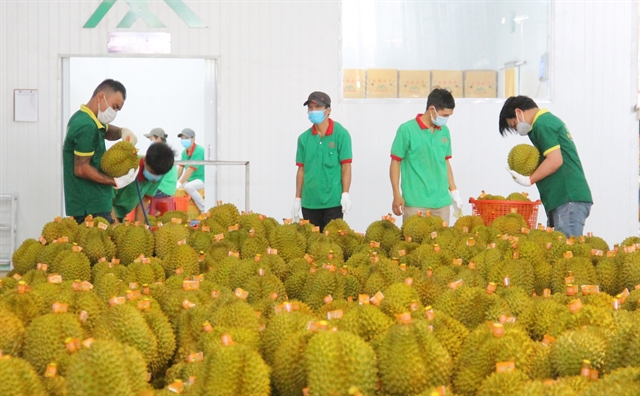 Society
Society

Nguyễn Giáp Đông, the head of the Ba Vì District Economy Division in Hà Nội, reports that his district is spearheading a 300-hectare banana-growing initiative that will span along theHồng (Red) and Đà rivers.

|
| Workers check the quality of durians before packing them for export in the Central Highlands province of Đắk Lắk. — VNA/VNS Photo Hoài Thu |
Nguyễn Giáp Đông, the head of the Ba Vì District Economy Division in Hà Nội, reports that his district is spearheading a 300-hectare banana-growing initiative that will span along the Hồng (Red) and Đà rivers.
This ambitious endeavour is expected to yield a significant return, with each hectare projected to generate between VNĐ300-350 million (US$12,700-14,800) annually.
Nguyễn Thị Nụ, director of the Thuận Mỹ Agricultural Cooperative in Ba Vì District, said that the cooperative grew organic bananas using fertilisers that are organic waste.
The cooperative invested in a pre-processing plant, a banana harvesting system and a cold storage system to make different products from bananas.
In Sơn La Province, the director of the provincial Department of Agriculture and Rural Development Hà Như Huệ said that Sơn La has a large area of fruit trees with 82,805ha.
The province exports mangos, longans, bananas, dragon fruit, plums and macadamia to different markets, including Australia, New Zealand, the US, China and European countries.
It has 34 companies specialised in packing fresh fruit for export.
At a forum to promote digital transformation in agricultural production held recently by the Ministry of Agriculture and Rural Development, the deputy director of the Department of Quality, Processing and Market Development Lê Thanh Hòa said that localities were applying production management software.
They digitise information and database of the raw material area.
So far, the country has about 4,600 planting area codes with an area of about 300,000ha, including fruit, rice, coffee, pepper and cashew.
The country has more than 2,000 product packing companies for export in 50 provinces and cities.
Raw material areas with planting area codes created favourable conditions for enterprises and cooperatives to bring scientific and technical advances into production, reduce input costs and post-harvest losses and increase products’ value when exporting.
Opportunities
Trần Ngọc Thanh, deputy chairman of the Việt Nam Organic Agriculture Association (VOAA), said that Việt Nam's organic agricultural production was developing strongly, especially after three years of implementing the organic agriculture project.
The export turnover of Việt Nam's organic agricultural products has reached over US$335 million per year and has been present in over 180 countries and territories.
With the European Union-Việt Nam Free Trade Agreement (EVFTA), the potential and opportunities for Việt Nam's organic agricultural products are increasingly open.
Referring to the opportunity to export organic products, Đỗ Việt Hà, a representative of the Việt Nam Trade Office in Germany, said that European consumers, especially Germans, paid great attention to products which were good for their health.
The trend of consuming organic products is increasing.
Sales of organic food in Germany have increased significantly over the past decade, from 6.64 billion euros in 2011 to almost 15.9 billion euros in 2021.
In Germany, 50 per cent of organic products are sold in retail supermarkets, 32 per cent are sold at supermarkets specialising in organic products and 18 per cent are consumed through other retail channels.
Therefore, she said, Vietnamese enterprises needed to make the most of opportunities and grasp consumption trends, regulations on food safety of importing countries and certification requirements for international organic consumption, to improve product quality and expand export markets for Vietnamese organic products.
Resolving difficulties
The organic raw material areas with planting codes play a great role, but while implementing them, localities still face many difficulties.
The raw material areas for agricultural production are still fragmented and small. Some farmers do not follow the organic production process and do not write planting diaries, making it difficult to keep a close watch on the products.
To remove obstacles and expand raw material areas with planting area codes, Ngô Tường Vy, director of the Chánh Thu Import Export Co Ltd in Bến Tre Province, said that building planting area codes were a basic standard to meet the requirements of importing countries.
Localities therefore must educate people that planting area codes are vital to selling products.
Director of Ameii Việt Nam Joint Stock Company Ngô Thu Hồng said that localities needed to support farmers in the production process with organic standards.
Provinces and cities should develop concentrated raw material areas following the scheme, and create conditions for enterprises and cooperatives to put scientific and technical advances into production to create high-quality agricultural products.
Deputy director of the Hà Nội Department of Agriculture and Rural Development Nguyễn Ngọc Sơn said that the municipal agriculture sector must continue to support cooperatives in applying Vietnamese Good Agricultural Practices (VietGAP), organic, and one commune one product (OCOP) certificates.
These areas will bring high-quality agricultural products for export in the near future.
Deputy Minister of Agriculture and Rural Development Phùng Đức Tiến said that to fulfil the target for 2022-23, in which the country will form five standard raw material areas with a total area of about 166,800ha, provinces and cities needed to develop raw material areas infrastructure.
Provinces and cities must promote technology and digital application from production to processing and consumption.
They also needed to promote educating people to convert inefficient crops to fruit trees, and building standard material areas to meet the demand of importing countries. — VNS




